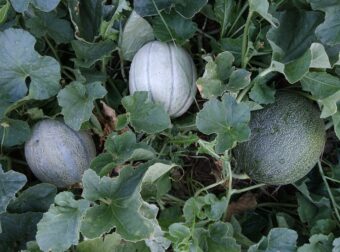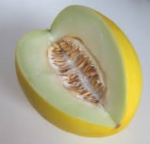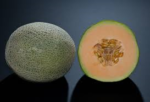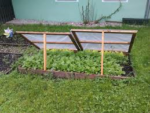In this article, we will be discussing the best way of growing melons in containers. Who amongst us does not like the sweet-tasting fruit of the melon plant, especially the Cantaloupe types. As most of us have a tinkling for melon, is it possible to grow this fruit in Container? Let us see.

Melons are so tempting to grow and they need a warm summer to do well. But that is the beauty of gardening, as anticipation of will it succeeds or not, is half the excitement. Long gone are the days in Victorian times where melons where grown in a heated greenhouse in large estates. It is now in the public domain to grow their own due to the breeding of more appropriate varieties.
If you are growing melons in containers then Cantaloupe types are the one to grow, which tend to be small, round and have marked textured skin.
GROWING MELONS IN THE UK IS NOT FOR THE FAINT-HEARTED
No matter what you level of gardening experience is growing melons here in the UK can be seen as a challenge?
Melons need the heat and protection of an unheated greenhouse, polytunnel, cold frame or cloches to do well. In hot summers, you can risk growing it outside and let then run along the ground but this is no guarantee.
Growing under cloches or cold frames is the best way in Southern counties, provided an early variety is chosen and the summer is a hot one. For more reliability grow in a cold greenhouse or polytunnel using an early or mid-season variety.

For true reliability, a heated greenhouse is an ultimate choice, as any type of melon can be grown here.
If you want to grow any type of melon listed on websites and catalogues, you need to maintain a minimum temperature of 18 degree Celsius at all times.
Melons tend to be raised from seed at home unless you buy potted planted from online stores or garden centres. A good way to tell if you will be successful with melon is if you have had success in growing cucumbers in your greenhouse. If you can grow cucumbers then you can grow melons but the humidity must be lower.
TYPES OF MELON
Melons tend to be classified depending on when the fruit ripens. If it ripens in late July to mid-August then it is an early variety, whilst mid-season melons tend to be ready in late August and the late varieties ripen at the beginning of September. It is often very difficult to classify melons, but the following is generally accepted:
WINTER (CASABA) MELON

These melons are large and oval with hard, yellow or green ribbed skin. Honeydew is a classic example. The flesh is pale green or white but never fragrant, but always sweet and juicy. This type generally does not do well in the UK.
NETTED (MUSK) MELON

This produces small, round or oval fruits with smooth skin that has a fibrous netting. The fruit is either yellowish-green or buff. It has a ‘melony’ smell but the flesh is green, orange or pink. It is juicy and sweet-tasting and it can be grown in the UK if you choose the right variety. Can do well in a cold greenhouse but many need heat to do well. Will not do well in a cold frame or under cloches.
CANTALOUPE MELONS

This produces round, oval or flattened fruits that have rough, textured skin that is greyish-green or buff.
The fruit tends to have distinct ‘Peachy’ aroma and its flesh is green, orange or pink and it is sweet and juicy. This is the most popular group to grow in cold greenhouses or cold frames.
GROWING MELONS IN CONTAINERS
In 9cm wide, individual pots full of seed sowing compost on a warm windowsill indoors, sow seed in early to mid-April. Cover the pots with Clingfilm and maintain a temperature of 18 degrees Celsius until the seedlings start to emerge. Once it does, you can remove the Clingfilm, whilst maintaining a night-time temperature of 16 degrees Celsius.
It is best planted sideways so that the seed does not rot in the pot full of seed compost. Once 4 true leaves emerge then you can start hardening off before planting in a cold greenhouse or cold frame.
Once it has reached the ideal size you can place the plant in an unheated greenhouse, polytunnel or cold frame in pots, grow bags or into the border in the greenhouse. If you are growing outside in a patio, plant in a container that is 25cm in diameter and facing a sunny wall. Plant out in late May to early June.
COLD FRAME PLANTING
Prepare the soil in April by digging a small handful of well-rotted manure or compost into the soil at the centre of the frame.

First, mount up the soil at the centre of the cold frame, then place the seedling in the mound, leaving 2.5cm of the root ball above the soil. Do not firm the plant in but water to settle the soil around the roots but make sure that water is kept away from the main stem. The plant should be planted in late May and watered when necessary.
In the cold frame, once the plant is inside and planted, strong sunlight has to be excluded for the first week or two. This is to allow the plant to adapt to its surroundings. It is advised to provide some sort of shade, especially so if the sun is bright.
GREENHOUSE PLANTING
In the greenhouse, you have 3 choices; to grow in a manure enriched soil border, in a 25cm diameter pot full of multipurpose compost, or in grow bags.
If you are growing in containers, you will need to ensure that a good support structure is included. Place one plant per container, ensuring it is 2.5cm above compost level.
If you are using a grow bag to grow your melons in then you will need to follow this regime:
First, place the growing bag on the greenhouse floor, then you need to place the support structure (More will be discussed later). Plant the seedlings, 2 per bag, as again leaving 2.5cm of the root ball above the surface of the bag. Water the plant in but do firm it, as this will prevent rotting of the roots at the base.
TRAINING IN A GREENHOUSE
As said previously before planting it is important to create a support frame, so that the plant will take the weight of the vine and fruit. You will need to stretch wire at regular intervals of 30cm apart to help support the vines. The wires should be supported with vine eyes that are placed 30cm away from the greenhouse glass. For example, a 2.4m tall greenhouse will have 7 wires.
Once the wire is in place, you need to tie a sturdy cane to the wire behind the plant. Once the cane is secure, you need to tie the main stem loosely to the cane. Any lateral that is below the first wire needs to be removed. Along each wire, there should be a lateral shoot, which needs to be trained along the wire. Removing any laterals that are growing between the wires.
The growing tip should be removed when it reaches the greenhouse eaves, at this point, it should be at least 1.8m high. Pinch out the growing tip of each lateral when 5 leaves have been produced. This induces the production of side-shots from which flower will be produced.
THE MELON PLANT PRODUCES TWO TYPES OF FLOWER
There are 2 types of flowers produced- a male that appears first and them the female flower with fruit behind that open later. Hand pollination will be necessary but you will have to wait until 6 female flowers are open, one for each separate lateral.
At this stage, remove one male flower, fold back the petals and push it into the centre of each female flower. This is best done at midday, where at least 4 flowers will at least be fertilised. Thinning the fruit and stopping the side-shoots will be necessary when the melons are marble-sized.
You will need to remove any fruit to leave one melon per lateral. Pinch out the lateral 2 leaves beyond the fruit. Any long will need to be pinched out, as they will take the energy away from fruit production.
If you have done this right, you will have 4 to 6 developing melons on each plant. Any further shoots or flowers that appear after the fruit develops will need to be removed.
LOOK AFTER THE MELON PLANTS WELL
The plant will need to be watered carefully when it is necessary. The compost should be moist at all time but never waterlogged. This could mean watering twice a day when the fruit is swelling, but no water should hit the stem. When the melon starts to ripen, reduce your watering rate. The fruit should be supported with a net attached once it is tennis-ball size, or the plant will collapse under the weight of the fruit.
Regular feeding of melon plants is necessary. Begin fertilising with a high potash fertiliser such as Phostrogen, when the fruits are the size of a golf ball. This must be repeated every week when the fruit is swelling.
At the early stages of plant growth, gentle dampen down all the greenhouse floor and misting may be required. Once the flower forms when it needs to be pollinated and when the fruits start to ripen, you will need to change the growing atmosphere. At this stage, the ventilators should be opened and the humidity reduced, as a dry atmosphere is required to prevent the fruit from rotting.
IN A COLD FRAME
Melons in cold frames are grown slightly different. After a week or two, when new growth can be seen then you can rest assure that the transplant has taken, then you can remove any shading material that is covering the glass. At the same time, you will need to start increasing the ventilation gradually.
Once the growing tip has developed 5 true leaves then it is time to pinch out the growing tip. This will cause the plant to form side-shoots. Once 3 weeks has elapsed you will need to choose the 4 strongest shoots and them train them as a cross, growing at each corner of the frame. Any additional shoots will need to be cut out as they are not required.

Once the flowers appear the frame of the cold frame should be opened to allow insects to pollinate, whilst closing it at night. If the weather is wet and dull and cool, do not open the cold frame. In this case, you will need to pollinate by hand in the same way you would pollinate in a cold greenhouse.
Thinning to one fruit per shoot is still required, whilst pinching out 2 leaves beyond the fruit, to aid its development. You will need to continually remove any other side-shoots or flowers that appear after the melon has successfully fruited.
YOU WILL NEED TO CONTROL THE VENTILATION
Keep the soil moist at all times but never waterlogged, especially so when you are thinning excessive fruits. When watering keep water off the stems and start to reduce the watering rate when the fruits start to ripen. Feeding is the same as a greenhouse-grown melon.
You will need to carefully control the ventilation depending on the weather and on the plant stage. In cool weather, reduce ventilation but increase ventilation in sunny, hot water and when the fruit is ripening. Apply shading material on the cold frame in July and August to prevent the leaves from getting sunscald.
Once the fruit is tennis ball size, you will need to physically support it to keep the fruit from touching the ground, as this will cause the fruit to rot. You can use a piece of wood, slate or tile to do this. The physical support must remain until the fruit is picked.
VARIETIES TO GROW
ALVARO
This is a charentais-type melon that produces medium, green-striped fruit with orange flesh. The mid-season variety can be grown successfully outdoors. The pale green skin turns yellow as they ripen but have a delightful perfume and a sweet and juicy taste.
EMIR
This is an ideal choice for a cold greenhouse, cold frames or under cloches. The fruits are small, oval shape, smooth, greenish-yellow with a sweet and juicy orange flesh. This is one melon that is tolerant of low temperatures and is recommended for northern districts. The fruits are produced in midseason.
GALIA
This well- known cantaloupe melon has large yellow fruits that are netted with gold stripes. The pale green flesh is sweet and has such a pleasant aroma. It is a vigorous variety and needs plenty of room to grow for this mid-season melon.
OGEN
This is a small cantaloupe type melon that has round, yellow fruits that have green ribs. The firm pale green flesh is juicy and sweet. It is one of the choices for cold frames or unheated greenhouses, but not the best. It fruits appear early in the Season.
SWEETHEART
This is the best melon to grow in an unheated greenhouse or cold frame. This medium-sized cantaloupe had greyish-green skins and its orange flesh is very attractive and full of flavour. If you have failed with melons in the past, this is one to go for. Like Ogen, the fruits are produced early in the season.
WHEN TO HARVEST MELON
It is an art to know when to plant melons, as you need to pick when they are fully ripe. There are some indicators- the end away from the stalk will give if gently pressed and the end towards the stalk will develop a circular crack. Cantaloupe-types develop a characteristic aroma and the fruit when lifted parts readily from the stalk. You really need to eat the fruit straight from the plant, although it will last a few days in the fridge.
CONCLUSIONS
In this article, we have discussed the best way to grow melons in containers. They are not easy to grow and need a lot of input from you in its training on wires, watering and feeding. If you fail to do any of this, do not be surprised if you do not have many fruits. Remember if you want to taste the sweet flesh of the melon, you will need to put the effort in.
If you want a variety to grow that has more success than others, then Sweetheart is the one for you and if you are up for the challenge and you have a cold greenhouse, why don’t you grow a melon today?
If you have any questions to ask, comments to make, please do so in the comment box below.
Happy melon growing.
